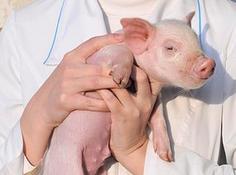Xenotransplantation comes closer to reality in pigs

On January 26, 2017 a group of researchers led by Jun Wu and Juan Carlos Izpisua Belmonte at the Salk Institute, had been able to show human stem cells forming in the tissue of a pig. Despite the difference of both human and pig is ninety million years of evolution.
The process known as Xenotransplantation, is when a transplant (whether it is blood, tissue or cells) is performed between two different species.
The benefits of Xenotransplantation can be immense, but with something like this, there can also be many blockades.
The need for organs within the United States of America is vital. Over 121, 272 people within the United States are on the waiting list for an organ transplant. The amount of organ transplants performed is 28, 954 and the amount of donors for organs is 14, 257 people in the year of 2013.
The amount of people on the waiting list can be drastically reduced if Xenotransplantation were a success but that will take time due to the ethical and immunological blocades.
With the development of science and technology, advancements thought to be impossible are becoming a reality, and for the first time scientists are able to grow human stem cells in a pig embryo.
The benefits of perfecting Xenotransplantation can also affect animals, not just for humans. Another team composed Tomoyuki Yamaguchi and Hideyuki Sato of the University of Tokyo, and Hiromitsu Nakauchi of Stanford, reversed diabetes in mice by replacing pancreas glands that was grown in a rat into the mice.
Some barriers include: ethical barriers on animal testing, immunological barriers and lack of necessary funding for research and development. The idea of Xenotransplantation can be frowned upon even by the public, due to transfer of animal organs into humans.
In 2005, Senator Sam Brownback proposed a bill that will fine a person one million dollars if anyone were to create and sell chimeras (a mix of two different species) with human cells in them.
According to Mrs. Beth Rojas, a Naugatuck High School biology and anatomy teacher, “I am more pro genetic modification. I know the funding, is through private funding because there are laws prohibiting government funding of this kind of research. So they are going to need access to funds in order to increase the opportunity. Either by changing laws or by accessing more private funding”.
The bill went nowhere but in 2015, the National Institutes of Health (N.I.H.) put a temporary ban on using public funding for Xenotransplantation due to the health risks that may ensue from the transplant. The ban is still currently in effect. Last August the N.I.H. offered to lift the ban, yet the issue must be examined by an expert committee to grant funds.
Hundreds of labs across the world that work to achieve the same goal, have worked for years on end and for the first time the fruit of their labor can be seen.
According to an interview conducted by The New York Times, “In the last 18 years, hundreds of labs, including ours, have tried to generate different cell types from human pluripotent stem cells in the culture dish with a cocktail of factors,” Dr. Izpisua Belmonte said. “But the cocktails are not identical to what the cells experience in the embryo. So I thought, ‘Why not let nature do the job?’”
Also according to an interview by The New York Times, “There isn’t a need to get into a debate about moral humanization if scientists target the organs where the human cells will go,” said Insoo Hyun, a medical ethicist at Case Western Reserve University. “Scientists are not making chimeras just for fun — it’s to relieve the dire shortage of transplantable organs.”
With the developments found in the initial rat and mouse experiment, scientists sought out to replicate the process but in pigs, which have more suitable sized organs for humans. But there is still a long way to go before it can be successfully used.
The perfection of Xenotransplantation is still far away, but if humanity and those who decide to pursue the developments are determined enough, then achievement is possible. Scientific development and discovery continue to play in the role of Xenotransplant accessibility and it continue to surprise humanity.
Time will continue to tell our technological and medical future.

I am a senior at NHS. I want to be a microbiologist or a biomedical engineer. I am taking this class because I enjoy writing and researching real time...







